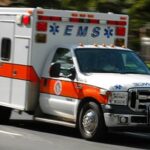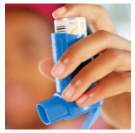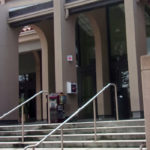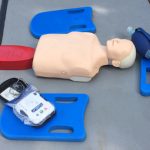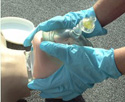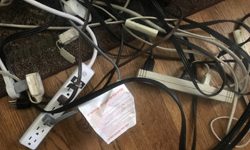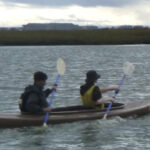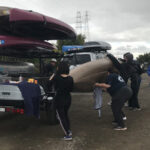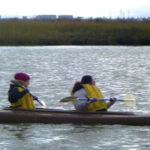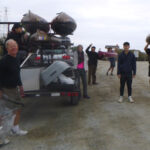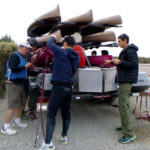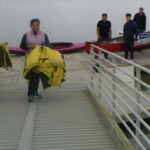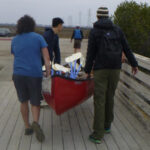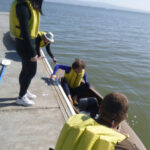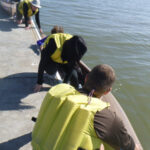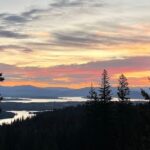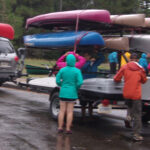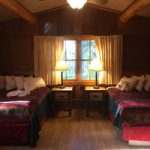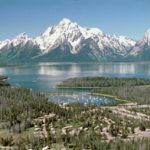Hlth 57A (Health 57A)
First Aid for the Community, Home, Wilderness and Disasters
is a one-unit class that is offered at De Anza College almost every quarter.
The De Anza College class is designed to cover more than the minimum first aid. Students who need first aid knowledge for their De Anza programs (or who just want to learn first aid, as many of my students have wanted as parents, coaches, scout leaders) also get in-depth coverage of laws that apply to giving first aid which makes a CPR/AED (cardiopulmonary resuscitation and automated external defibrillation) class easier.
HLTH57A students who have gone on to
take EMT training and lifeguard training
have told me they were much more prepared than others in their classes.
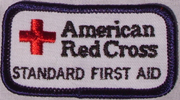 Upon successful completion of the course, each participant can receive an (optional) American Red Cross certification in First Aid (valid two years). Students who fully attend all of the four class sessions in HLTH57A have a 100% success rate at earning the Red Cross First Aid certificate.
Upon successful completion of the course, each participant can receive an (optional) American Red Cross certification in First Aid (valid two years). Students who fully attend all of the four class sessions in HLTH57A have a 100% success rate at earning the Red Cross First Aid certificate.
This class is not a CPR / AED (cardiopulmonary resuscitation and automated external defibrillation) class, but includes parts of it and taking this class before you take a CPR/AED class will make the CPR/AED class easier.
We meet for only four sessions, not all quarter.
For Winter quarter 2026 look in the schedule of classes for
HLTH 57A, (39666)
a 4 session course with meetings on Friday afternoons, Jan. 9, 16, 23 and Feb. 6, 2026.
1:30 – 4:20 p.m.
(Winter quarter we do not meet four Fridays in a row. because the instructor will be on a field trip with students on the weekend of Jan. 30 to Feb 1.)
Enrollment and registration steps are at: https://www.deanza.edu/apply-and-register/register/index.html
High School students can take classes at De Anza College, see: https://www.deanza.edu/admissions/dual/
We finish before finals week and do not meet during finals week.
——————————————————————-
The college website https://www.deanza.edu/return-to-campus/students.html
recently said that proof of vaccinations are no longer required, but
“Face masks are still strongly recommended and may be required in some classrooms or offices on campus.”
(Unless campus rules change) face masks will not be required in the classroom for HLTH 57A, but anyone can wear one if they want.
– – – – – – – – – –
We will leave doors to the classroom open for full ventilation,
so warm layers (sweater, jacket, pants rather than shorts, maybe a knit hat, etc.)
that you can put on or remove as needed, would be wise.
The college advises, and health care and child care professionals often enrolled in this class know,
that people should remember to wash hands frequently.
——————————————————————-
(Your instructor is fully vaccinated with two Moderna shots, four boosters and the 2025-2026 Pfizer Covid vaccine, as well as flu shots each year for years!)
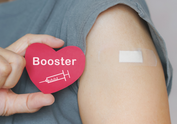
– – – – – – – – – –
In the schedule of classes you will see a green textbook icon,
a small round green icon with $0 in the center, or a green textbook
used to designate free textbooks next to listings for some classes, including HLTH57A:
“Classes with the green book (OER) designation use course materials such as textbooks
that are of zero cost to the student except for school supplies typically required in the course.”
There will be zero cost for the downloadable reading materials for this class.
Since the Red Cross textbook “First Aid / CPR / AED Participants Manual” ($12.95) is not required for people to be able to certify, it is not required for students to buy and there will be no assigned reading from it.
It combines first aid with Cardiopulmonary Resuscitation and Automated External Defibrillation for Lay Responders (CPR for the general public),
and most of the book is about that kind of CPR/AED.
The CPR for the general public is very different than the procedures taught in advanced CPR classes (CPR PRO) that most students in the De Anza first aid class will need, for example, Cardiopulmonary Resuscitation and Automated External Defibrillation for Professional Rescuers and Health Care Providers.
Doing reading about the lower level CPR certification
(which is not required for this class and the Red Cross first aid certification you can earn in this class) could end up confusing people.
– – – – – – – – – – – – – – – – – – – – – – – – – – – – – – – – – – –
To find the classroom, S56, go to:
https://www.deanza.edu/maps-and-tours/documents/Campus-Map-De-Anza-College.pdf
Look for the S5 building. S56 is in the bottom left hand corner of the S5 building.
Or look at the map with room numbers of buildings at:
https://www.deanza.edu/maps-and-tours/s_quad.html
And notice that the nearest restrooms are in the S6 building, across from our classroom. BUT they are being renovated and will not be available.

A De Anza webpage https://www.deanza.edu/measure-g/construction.html
said “Signs will be posted to provide directions to other restrooms available nearby.” It could be a good idea to come early to class and find ( go to and take a look at the location) the other restrooms.
– – – – – – – – – – – – – – – – – – – – – – – – – – – – – – – – – – –
Designated quiet spaces with power and Wi-Fi on campus can be found at:
https://www.deanza.edu/students/zoom-spaces
These can be useful if you decide to take an online class that meets near the time of one of your on-campus classes.
_____________________________________________
“The class is full and I want to add!” I receive many emails from students wanting to add the class, or who are already on the waitlist.
I can’t add anyone until after the class has met for the first time.
Sometimes students who are enrolled do not attend, making room for others,
plus I often take extra students,
so attend the first class, on time, and you might be added.
The first day of class is also the last day to add the class.
each class day before you take a seat in the classroom.
To make checking in for class go faster, please bring to class each day
either your cell phone with your name in large letters showing 
or a piece of paper with your name printed on it in large letters.
Put your first and last name as it is on the campus records, not a nickname you prefer. For example, the person holding the paper below might usually go by Sam, rather than his name Samuel that will be on the roll sheet:
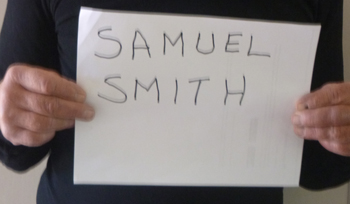
– – – – – – – – – – – – – – – – – – – – – – – – – – – – – – – – – – – – – – – – – – – – – – – – – – – – – – – – – –
Reading assignments:
FIRST reading assignments :
If you find this in time to read the syllabus before the class starts,
you will be better able to ask questions the first time we meet,
if you do not find it before the first class, you should read it by the second class session:
– – – HLTH 57A course syllabus. It has the grading standards, requirements for certification, details about paying for the Red Cross certification card (if you want or need the certification), class rules and more. You are responsible for the material in this document. (This is also known as the ‘greensheet’ in many De Anza classes.)
If you can complete this first section of reading before the first class,
you will get more out of the lecture.
If not, you should have read these FIRST reading assignments and the SECOND reading assignments by the second class session.
 Bloodborne Pathogens quick facts which includes an adult recommended vaccinations schedule, and areas of hands that are most often missed by healthcare providers when using alcohol-based hand sanitizer.
Bloodborne Pathogens quick facts which includes an adult recommended vaccinations schedule, and areas of hands that are most often missed by healthcare providers when using alcohol-based hand sanitizer.
advance care directives which includes a link to get a free copy of an advance care directive
which includes:
what to do if you dial 911 by mistake
advice for using a cell phone to call 911
situations to NOT call 911
and the answer to the question; “Why Shouldn’t I Just Drive the Patient Myself” instead of getting an ambulance
Rule #1 Don’t make things worse
-don’t aggravate injuries-(don’t move anything you think might be broken)
-don’t move victim (especially if you suspect a spinal injury) unless you absolutely must
-don’t increase danger to victim
-don’t expose others to risk and create more victims
-don’t force first aid on a conscious, sane, sober adult who doesn’t want it
(get consent/explain what you are doing and keep getting consent/explaining as you go along)
Please note that Good Samaritan laws do not grant anyone immunity against law suits.
Note this important fact that many students do not know when they come into the class:
Unconsciousness and being asleep are not the same.
Also, you can be fully awake and only partially conscious.
read: levels of consciousness: person, place, time and event, which also has the answer to a question on the final exam.
AVPU
Alert: able to respond appropriately to questions (including person, place, time and event)
Verbal: Responds appropriately to verbal stimuli when you speak or shout
Painful: Only responds to painful stimuli, such as a pinch
Unresponsive: Does not respond; no gag or cough reflex
a response could include grimacing, rolling away from your voice, moaning, (instead of talking to you)
Normal capillary refill , which we will “test” in class, is 2 to 3 seconds (not effective on very cold fingers)
Causes of fainting, altered mental status, sudden altered mental status, unconsciousness
Take a look at the answer
(and some wrong answers previous students did not get credit for)
to a question on the final exam: If you suspect a stroke
The class will cover material about administration of medications, either by assisting people with their prescriptions or by actually administering them to people. None of this will be adequate training or certification for any of you to be able to administer medications, the material in class is just for you to have an idea of what happens during administration. At your workplace, you might get additional training to be able to administer medications, including, but not limited to, an epinephrine auto-injector (prescribed to that person), asthma inhaler (or other inhaled medication prescribed to that person ) or naloxone. And note that in some other countries naloxone may only be administered by doctors, nurses, EMTs / paramedics. In some other countries, police officers and the general public are also authorized to use it.
Read Anaphylaxis quick facts which includes prevention and an answer to the question:
Can a person who is prescribed an epi-pen risk going into the wilderness?
SECOND reading assignments, which should be read (along with the first reading assignments), by the second class session:
Try to see if you can answer these questions about heart attacks and cardiac arrest.
Take a look at photos of
AED locations at De Anza College
and, if you want to
(especially if you already are certified in CPR/AED – cardiopulmonary resuscitation and automated external defibrillation),
find out the locations of campus AEDs (automated external defibrillators) nearest your classrooms.
——————————————————————-
Optional reading, or just scroll through, to get ready for a CPR (cardiopulmonary resuscitation) class: CPR manikin use
Please note that the names for levels of CPR training in the United States are different than what you might have learned in another country. The European Resuscitation Council has offered BLS (Basic Life Support), ILS (Intermediate Life Support) and ALS (Advanced Life Support), as well as various levels of “Paediatric Life Support,” with different skills training than United States classes in Basic Life Support or CPR/AED for Professional Rescuers and Health Care Providers. They might reference a “Triple Airway Manoeuver (Head tilt-Chin lift-Jaw thrust)”
A Royal Lifesaving Society, New Zealand manual uses these acronyms:
EAR – expired air resuscitation (rescue breathing)
ECC – external cardiac compression (EAR plus ECC = CPR)
and they refer to one operator and two operator CPR (one rescuer and two rescuer CPR)
Please note that people in some other countries do CPR differently, such as starting with 5 rescue breaths instead of 1 or 2.
CERP is not a different way of doing CPR, it refers to a Cardiac Emergency Response Plan (CERP), for example in a school.
Citizen CPR is not a different way of doing CPR, it has been described as “a system of care involving the entire community . . . fostering a culture of preparedness and response within communities.”
AND note that the European Resuscitation Council (ERC), Federation Europeenne Des Auto-Ecoles (European Driving Schools Association EFA) reports that their survey “revealed that in 44% of European countries, citizens are required to undergo BLS” (Basic Life Support cardiopulmonary resuscitation) “courses for certain driving licenses. The ERC and the EFA are determined to make these courses mandatory across Europe, increasing the number of potential CPR responders.” Scroll down to see a map of these countries at: Learn to Drive, Learn CPR
——————————————————————-
Read Seizures, causes of and basic care for
Injuries Quick Facts which includes: Will this wound require stitches?
and Critical Burns (you do not need to call 911 for every burn, but for critical burns you do need to call).
Choking risk factors and prevention (adults and children)
Heat Illnesses which includes warnings about dehydration.
Cold illness and injuries (hypothermia, frostbite and prevention)
At altitude which details mountain sickness (AMS), that almost everyone gets when they travel to higher-than-Silicon-Valley-elevations in any mountain range. And it has details about high-altitude cerebral edema (HACE), and high-altitude pulmonary edema (HAPE). HACE and HAPE can be fatal unless people are aware of them and ready to descend to a lower altitude.
Descending (going down to a lower elevation) is the required first aid.
Please be sure you noted the many risks, and ways to reduce exposure to illicit fentanyl, that are described in CDC material at the Bloodborne Pathogens quick facts that was assigned reading earlier in the class.
And note that the protocols you follow at work could be different than what you learn in this class.
_________________________________________________________
Consider this situation and give some thought to
what you might have been able to do to help
if you were there when it happened or just after it happened:
In Grand Teton National park, this tour bus “toppled onto its side & slid several feet down Highway 89/287, creating a mass casualty incident that sent 27 people to area hospitals & closed the park road for 5 hours . . . Twenty-four people were transported by three Grand Teton ambulances, a Jackson Hole Fire/EMS ambulance and a Grand Teton Lodge Company passenger van to receive medical care at St. John’s Medical Center in Jackson, Wyoming. Two seriously injured passengers were flown to Eastern Idaho Regional Medical Center (EIRMC) in Idaho Falls via two EIRMC life-flight helicopters that were able to land near the accident site.. . Although the bus did not completely roll over, the impact of the crash caused some level of injury to all 27 bus occupants, making this a mass casualty incident.” A park service spokesperson said: “the bus driver, who was injured in the crash, veered on to the side of the road and then overturned, apparently because the driver turned too sharply to get back to the pavement.”
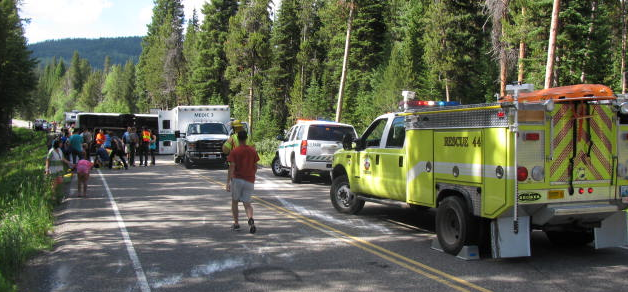
_________________________________________________________
THIRD reading assignments, which should be read by the third class session:
Times to suspect a spinal injury (symptoms, causes, signs of spinal injury)
and Concussion signs and symptoms, prevention
![]()
A transcript of what you heard in all of the videos is here.
![]()
You will turn in homework assignments at the college Canvas page, by the date(s) listed on Canvas, not by printing pieces of paper and bringing them to class, not by email or by putting them in a mailbox on campus.
A modern computer with updated Web browsers (Firefox, Safari, or Chrome) and an Internet connection is all you need. Most public libraries have a few computers for people to use. The De Anza College library has a lab where you can access many computers: https://www.deanza.edu/library/librarycomputer.html and a few laptops for loan to students: https://www.deanza.edu/students/computers.html
Students receive a link to Canvas after they register for each class, on a date specified by the college.
(I can’t tell you when to expect the link to Canvas, but it should be shortly before the quarter starts.)
The Canvas pages will not be available to submit the work until about a week before the class meets for the first time, but all the homework will be available at this webpage for people to read any time.
If you want to, you can do almost all the homework assignments listed at this webpage in advance of when they become available at the Canvas webpage, save them on your computer, then copy and paste them into Canvas.
(Look below for all assignments at: CLASS CALENDAR with HOMEWORK )
Once you have enrolled in the class and get the code, you can access all Canvas materials by going to any De Anza College webpage, and in the tool bar at the top, which should look like this:
click on the Canvas tab, which should look like this:
![]()
The left hand side bar at most Canvas class webpages for fully online classes might have many topics:

but you will only see a few of these at our class Canvas page.
In your fully online De Anza College classes you will have group projects, class discussions, conferences, attendance at /in Canvas, but since we will meet in person at a De Anza College classroom we will do none of those activities online.
Since we meet in person in a classroom, we will also not use the usual “conversations,” “groups,” “collaborations,” or “peer reviews” that fully online classes use to talk to and work with each other online at Canvas.
If you have questions you will not “submit” them on Canvas like you would in a totally online class, you should ask them in class, in person. You also should not put questions you want an answer to in your homework when you enter it at Canvas, as I may not read all the homework until mid-way or late into the quarter and you will get a faster answer to to your question(s) if you ask them during class.
Please note that the most important calendar for our classes is not the abbreviated calendar you will find at Canvas, but rather is the one below at this webpage,
A common mistake happens when, as a student described it, you have
“multiple assignment windows open at the same time”
and post the wrong homework into the wrong tab.
(Or even homework from a different class you are taking).
I will not be notifying students if they make this mistake or if they only submit one, two, three or four examples of something new they learned from a reading instead of the five new or most important things learned. You will also not receive credit if you do not give examples, and write instead that none of the reading was new or important to you.
Homework must be submitted in English. (A student who was using a translation app mistakenly posted their homework in a language other than English and did not receive credit for it.)
Each student is responsible for completing homework as described and on time, according to the deadlines at Canvas. (Students have been successful at this . . .
in Spring 2025, 12 students got all answers correct on the final exam.
95+% earned some kind of an A (mostly A+), one B+.
in Winter 2025, seven students got perfect scores on the final exam, 95+% earned some kind of an A (mostly A+), one B-.
Fall 2024, seven students got all answers correct on the final exam. All students got some kind of an A grade (mostly A+). )
The newest reference for students using Canvas is at the Canvas Resource Library for Students, which the college says is “a valuable source of information for students who are new to Canvas. This is a public Canvas course, and you can share the link with students in your course”
https://deanza.instructure.com/courses/3382
Students tell me that watching these videos before they did work on Canvas helped them a lot:
https://community.canvaslms.com/videos/1124-canvas-overview-students
https://community.canvaslms.com/videos/3966-dashboard-overview-students
https://community.canvaslms.com/videos/1122-assignments-overview-students
https://community.canvaslms.com/videos/1134-quizzes-students
https://community.canvaslms.com/videos/1123-calendar-students
________________________________
______________________________________________
CLASS CALENDAR with HOMEWORK
( Along with the reading assignments for each day of class listed above),
homework is listed below for each day of class.
Please note that the due date on Canvas should be the same as mentioned here at the class calendar, but most of the work is available at Canvas much earlier than it is due.
You will find at Canvas the final due date / time that each can be submitted for full credit.
Note that you should not post a link to a document you stored at another computer
(and you will not get credit for it if you do).
You need to enter the full text at the Canvas homework page so there is a permanent copy of it.
Entering the full text means typing it in at Canvas. If you write your homework as a Word Document on an iPad or your computer, for example, then make a photo of it and paste the photo into the homework submission it looks like this to your instructor (an empty rectangle with no words), even though it looks okay to you :

(The row of dots above, after the assignment name “secondary assessment” are because I blocked out the name of the student who made this mistake.)
All homework must be done individually by each student, not as a group project.
Homework projects will all be listed at this class webpage, and be available here for your review after the class is over.
People have completed homework before the quarter starts, saved it on their computer, and turned it in at the start of the class.
______________________________________________
__________________________________
Homework due the second class session:
If you find this in time to read the syllabus before the class starts, you will be better able to ask questions the first time we meet,
if you do not find it before the first class, you should read it by the second class session:
– – – Read the HLTH 57A course syllabus. It has the grading standards, requirements for certification, details about paying for the Red Cross certification card (if you want or need the certification), class rules and more. You are responsible for the material in this document. (This is also known as the ‘greensheet’ in many De Anza classes.)
Complete these projects: Again, you will turn these in at Canvas.
1) Read the first aid Secondary Assessment and briefly write up the five most important new things you learned from the reading. If you already knew it all, briefly write up the most important things.
2) Read First Aid Facts and Fallacies and write up five things that you learned from the reading, either those you did not know, or that you think some or many people do not know, or some combination. You do not need to click on and read all the links, but most are short reads.
3) Read How to rescue a drowning victim using a reaching assist or a shepherd’s crook and list the five most important things at the webpage.
_____________________
You might not be completing the conscious choking skill on a class member, but if we do, or when you do in a CPR class. . .
“When practicing on a student in class you should only simulate back blows and abdominal thrusts (do not apply pressure) so you do not hurt anyone.”
to be farther apart from each other, we might use this practice method:
and note: “If the conscious choking victim is much taller than you and you can’t get into a proper position to give back blows and/or abdominal thrusts, you can ask them to kneel.”
_____________________
________________________________
______________________________________________
__________________________________
Homework due the third class session:
_____________________
1) Complete this project: a First Aid for Public Safety Personnel class listed
When To Suspect a Head, Neck, or Back Injury:
Any fall greater than victim’s height
Any motor vehicle collision
A person found unconscious for unknown reasons
Any injury that penetrates the head or trunk
A motor vehicle crash involving a driver or passengers not wearing safety belts
Any person thrown from a motor vehicle
Any injury in which a victim’s helmet is broken
Compare these to the list at: Times to suspect a spinal injury (symptoms, causes, signs of spinal injury) and write up the five times to suspect a spinal injury listed at the webpage, but not listed above, that you think you are the most likely to ever see.
_____________________
2) Complete this project: Signs and Symptoms of Concussion can be grouped into four categories:
(Quoting from an instructors manual):
“Thinking and remembering: The person may seem confused, dazed or “out of it,” or have trouble remembering recent events.
Physical: The person may feel nauseated or vomit, complain of a headache, or be sensitive to bright lights or noise.
Emotional: The person may seem irritable, sad or agitated.
Behavioral: The person may sleep more or less than usual. Children may also show changes in eating or playing habits.”
Compare this to the list at: Concussion signs and symptoms, prevention and write up the five signs and symptoms of a concussion listed at the webpage, but not listed above, that you think you are the most likely to ever see.
_____________________
3) Complete this project: Read Fire safety then write up five safety items at that fire safety webpage that you think you most need to pay attention to.
________________________________
______________________________________________
__________________________________
Homework due the fourth (last) class session:
Complete these projects
1) Read Cultural issues in first aid and write up the five most important things you learned at that webpage. If you already knew it all, briefly write up the five most important things.
(Something new from the webpage, not from your other class readings.
For example, how to obtain consent is in your readings, so you should not use it as an answer to this assignment.)
_____________________
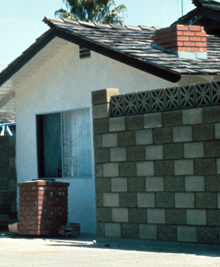
2) Read earthquake home hazards survey and write up the five most important things you need to do, as described at that webpage. If you do not find anything you think is important for you to do, write up the five things to do you think are most important for most people to do.
_____________________

3) Read Disaster planning write up the five most important things listed at that webpage, that you need to do.
If you do not find anything you think is important for you to do, write up the five things from the webpage to do you think are most important for most people to do.
_____________________
4) The Wilderness Medical Society defines wilderness as any situation
when you are “more than one hour away from definitive medical care.”
This could be your own home after an earthquake or other disaster as well as camping.
Read wilderness first aid outline and write up the five most important things you learned by reading that webpage beyond what is in other class readings.
_____________________
optional extra credit:
One of these will be accepted as extra credit only if you completed all the other assignments due the fourth class session:
Even if you don’t have an infant or toddler, one might visit. Crawl around your home and look for unsuspected hazards at infant/child level. Write up five or more you find.
You could look for things like those listed as risks for choking at the Choking risk factors and prevention webpage:

How many dust-covered cords do you have coming from that one outlet in that back corner of the room? Are you sure it is not a fire hazard? (Yes, this photo was staged.)
OR
Read Leave no trace write up five things from the page you personally can do, and encourage friends to do, that can prevent injuries and other need(s) for first aid.
OR
Read vehicle repair safety write up five things from the page you personally can do, and encourage friends to do, that can prevent injuries and other need(s) for first aid.
__________________________
In preparation for the final, it could be wise to read again:
If you suspect a stroke, a question on the HLTH 57A final exam, which includes correct and WRONG answers.
levels of consciousness: person, place, time and event, also has the answer to a question on the final exam.
and the first aid Secondary Assessment S.A.M.P.L.E. and O,P,Q,R,S,T are also answers to questions on your final exam.
Knowing S.A.M.P.L.E. is required for an E.M.T. / Paramedic and in a Red Cross lifeguard certification class.
_______________________________________________________
Before the last class, read this document you will be signing during the last class: HLTH57A card fee agreement
After the last class I will turn in the list of people who want the certification to the De Anza Cashiers Office and they will set up payments for everyone who earned it (and choose to pay for it).
The payments might not be set up until Monday morning, so please do not expect to see anything over the weekend.
You will be paying for it on-line, the same place you paid student fees.
De Anza had these instructions for paying online:
When Paying Online
Navigating the Bill Payment Feature in MyPortal
- To access the Bill Payment system, log in to My Portal and locate the card for “Bill Payment.”
- Click Pay Now to view your account or make payments, then select “Pay Now” or “Refund Request” or “Payment Plan”
the card for Bill Payment looks like this:
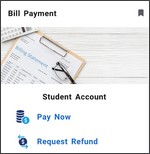
The college gave me these directions for how to pay to pass on to you:
“You should pay your certificate fee online – through MyPortal – with a VISA, MasterCard, or Discover card.
Click on the “Bill Payment” card .
Once on the payment system, if the amount due is more than your fee, you may choose to pay only the $34.00.”
It might be listed as DA B/H Red Cross Certif Fee.
The DA B/H stands for De Anza College Biological and Health Sciences
– the division at De Anza that offers the class.
If you already have a credit of $34 or more in your account, the $34 will be automatically paid.
Details about the certification are in the HLTH57A course syllabus.
_______________________________________________________
You can expect to get an email with the digital cert
(that you can print in wallet card or 8 1/2 X 11 format),
within two weeks after the last day of class (the payments and paperwork takes time to complete).
Beginning in spring quarter, 2022 the email with the digital cert was sent from
no-reply no-reply@redcross.org
If you look for the email with your digital cert
by searching Red Cross it might not turn up for you
(especially if your spam system decided that “no reply” is a spam email).
As of Spring 2025 the email was titled:
Your Red Cross Training Completion Certificate & CE Info
(Previously the email had been titled: Completion Certificates for your Red Cross Training.)
_______________________________________________________
The Final Exam
There is no longer a Red Cross multiple choice exam for certification,
but we will have a written final during the fourth (last) class session.
Almost all the questions will be given to you in advance.
You will not need a scantron.
We will start class by finishing any skills work and lecture not yet completed, then take a break, then take the final exam.
_________________________________________________
_________________________________________________
After an earthquake, for example, Radio Cupertino, at 1670 A.M. will broadcast “the latest information on the nature of the emergency, the impact of the emergency on the community, and instructions for local residents.” I am a member of the Cupertino Community Emergency Response Team (CERT) and Cupertino Medical Reserve Corps and always recommend CERT training, available for any local city you live or work in.
Generally, the vaccinations you got as a child will protect you the rest of your life, with a few exceptions. An adult recommended vaccinations schedule is at
https://www.cdc.gov/vaccines/?CDC_AAref_Val=https://www.cdc.gov/vaccines/schedules/index.html
If you want to become an EMT, be sure your immunizations for TB, MMR (measles, mumps, and rubella), varicella (chicken pox) also known as whooping cough, Hep. B, and tetanus / DTaP (tetanus, diphtheria, and pertussis) are up to date before you enroll in the program.
“evidence shows that vaccines do not cause several conditions. For example, the MMR vaccine is not associated with autism or childhood diabetes. Also, the DTaP vaccine is not associated with diabetes and the influenza vaccine given as a shot does not exacerbate asthma”
is a quote from: Adverse Effects of Vaccines, Evidence and Causality
https://nap.nationalacademies.org/catalog/13164/adverse-effects-of-vaccines-evidence-and-causality
To find out about the Bay Area Critical Incident Stress Management Team go to: http://www.billwilsoncenter.org/services/all/critical.html
– – – – – – – – – – – – – – – – – – – – – – – – – – – – – – – – – – –
epi-pen info. The U.S. Food and Drug Administration (FDA) has made updates to the patient instructions for epinephrine auto-injectors:
http://www.accessdata.fda.gov/drugsatfda_docs/label/2016/019430s061lbl.pdf
Especially note the Injection-Related Complications, for example, “do not inject intravenously, into a buttock, digits, hands or feet.. . Hold leg firmly during injection. Lacerations, bent needles, and embedded needles have been reported when EpiPen and EpiPen Jr have been injected into the thigh of young children who are uncooperative and kick or move during an injection.”
– – – – – – – – – – – – – – – – – – – – – – – – – – – – – – – – – – –
If the victim has a service dog: https://www.emsworld.com/article/219790/what-will-you-do-dog
Is your facility user friendly for all your customers/patients? Take a look at an Americans with Disabilities Act, ADA Guide for Small Businesses:
https://www.ada.gov/resources/title-iii-primer/
https://archive.ada.gov/lawenfcomm.htm has what percentage of speech reading (reading lips) by deaf people is understood (about one third of spoken words are understood) and practical suggestions for effective communication
– – – – – – – – – – – – – – – – – – – – – – – – – – – – – – – – – – –
In class we practice removing Latex-Free Disposable Gloves
Why latex-free?
“. . . With more widespread use of Natural Rubber Latex gloves after 1987 there was an increase in reported NRL
sensitization and allergic reactions among patients and among employees, notably health care employees. In rare cases, these allergic reactions can be fatal.. .”
this is from Potential for Sensitization and Possible Allergic Reaction To Natural Rubber Latex Gloves and other Natural Rubber Products
https://www.osha.gov/sites/default/files/publications/shib012808.pdf
– – – – – – – – – – – – – – – – – – – – – – – – – – – – – – – – – – –
The Red Cross provides access to the textbook
“American Red Cross First Aid / CPR/ AED Participant’s manual”
after students have successfully completed a first aid class
and earned and paid for the certification.
It includes info on the following subjects that I am offering as optional reading during our class:
Dressing for Cold Weather. Wilderness adventure books warn that ‘cotton kills’: read more about proper clothing for outdoor adventures to prevent hypothermia at: Snow or rain camp must-haves.
lowering the Risk for Tick-Borne Illnesses, insect repellant has answers to questions about the percentage of DEET needed in an effective insect repellant, toxicity allergies, and more. (Removing a tick is covered in Wilderness First Aid ).
Avoiding Lightning-Strike Injuries, Thunderstorm and lightning safety includes the answer to the question: Why can’t you swim during a lightning storm? A strike on a lake doesn’t kill all the fish in the lake.
Safety at Home. Please also see: hazardous household chemical mixtures
Bicycle safety, see also: Grand Tetons biking
Water Safety info. If you go on an Outdoor Club adventure kayaking you must wear a properly fitted, fully buckled lifejacket. Read more at: Why you should wear a lifejacket and we have assigned reading on how to do a simple pool rescue.
And if it interests you, also see: rogue or sneaker waves,
Yosemite Valley Rafting Advice
Swimming in Yosemite National Park
They are usually held in Conference rooms A/B
De Anza College Conference rooms A and B are upstairs in the Campus Center.
A closed-captioned version of the active shooter “RUN / HIDE / FIGHT” video is at:
https://www.youtube.com/watch?v=5mzI_5aj4Vs
in Spanish: https://www.youtube.com/watch?v=8fgwh34h7D4&feature=youtu.be
in Vietnamese: https://www.youtube.com/watch?v=2FPJLOWvbvw&feature=youtu.be
For an introduction to (CPR) cardiopulmonary resuscitation and the use of an AED, go to:
and take a look at the page of photos of AED locations on our campus
In anticipation of taking a CPR certification class, please see: How to pass a Red Cross written test for advice.
Foothill College has EMT training. “Students who successfully complete either the credit or non-credit course will receive a course completion certificate and are eligible to take the National Registry of EMT licensure exam.” “Registration is free for Noncredit EMR & EMT Courses.”
https://catalog.foothill.edu/degrees-certificates/non-credit-emergency-medical-technology/
Community Emergency Response Team training (CERT)
A link you can send to friends and family about Do it yourself earthquake preparedness:
Some of the true stories I use in class are at: fatal, near fatal or close call incidents/accidents in camping, backpacking, climbing and mountaineering
Using a campsite food storage locker
How bears break into cars, what to do if you see a bear and more is at: Bears
At altitude has info about sunburn, hiking, diet at higher altitudes. It includes why your tent mate might seem to stop breathing and links to High Altitude Cerebral Edema and High Altitude Pulmonary Edema tutorials.
Hiking Advice has hot weather hiking advice, hiking logistics and the answer to the question: When is the best time of day to cross a mountain stream?
Snow camp weather, hike safety and first aid considerations has trail safety notes, and info about mountain lions
_________________________________________________
– – – – – – – – – – – – – – – – – – – – – – – – – – – – – – – – – – – – – – – – – – – – – – – – – – – – – – – – – –

If you are in a profession that requires them (nursing, for example) Continuing Education Units (CEUs) might be available after you complete this course. continuing education credits (units)
![]()
programs for student success in all kinds of classes, including tutorials, readiness, academic skills, instructional computing and more:
http://deanza.edu/studentsuccess/
More students qualify for financial aid than use it or even know they qualify. There are enrollment fee waivers you can apply for online which take about a week to get an answer. For all the details go to:
http://deanza.edu/fees-and-financial-aid/
You don’t have to pay for all your classes/fees at once. De Anza has an installment payment plan that allows you to defer most of your payments. Go to: http://deanza.edu/cashier/installment_plan.html
De Anza College offers many scholarships, some of which have few applicants!
Check out the loot:
http://deanza.edu/financialaid/types/scholarships.html
The De Anza College Food Pantry (also known as the Campus Cupboard) provides food to students in need. You can get a bag of groceries with few forms to fill out. http://deanza.edu/outreach/food_pantry.html
Various local businesses give discounts to De Anza Associated Student Body card holders. A page of discounts (mostly 10% off food) is at http://www.deanza.edu/dasb/discounts.html/index.html
De Anza College offers offers help to quit smoking
https://www.deanza.edu/healthservices/wellness/quitsmoke.html
“Thirdhand smoke is residual nicotine and other chemicals left on indoor surfaces by tobacco smoke. People are exposed to these chemicals by touching contaminated surfaces or breathing in the off-gassing from these surfaces. This residue is thought to react with common indoor pollutants to create a toxic mix including cancer causing compounds, posing a potential health hazard to nonsmokers — especially children.
Thirdhand smoke clings to clothes, furniture, drapes, walls, bedding, carpets, dust, vehicles and other surfaces long after smoking has stopped. . . ”
https://www.mayoclinic.org/healthy-lifestyle/adult-health/expert-answers/third-hand-smoke/faq-20057791
“Family Issues, romantic relationship difficulties, anxiety, stress” and other
personal issues should preferably be dealt with while they are not a big deal,
before they do become a big deal.
“From time to time, problems of everyday living can be resolved through talking with friends, family, or someone whom we trust to help us. However, there are times when seeking help outside of one’s familiar environment might be more helpful. Psychological Services is here to meet such needs.” https://www.deanza.edu/psychologicalservices/services/
https://www.deanza.edu/resources/tbh.html
– – – – – – – – – – – – – – – – – –
The De Anza Library has free access for current students to the New York Times. Go to the library database page: https://www.deanza.edu/library/articledata.html and click on The New York Times. At the next screen, log in with your Portal IDs. On the next screen, create an account.
– – – – – – – – – – – – – – – – – –
https://www.amazon.com/medical-id-tags/s?k=medical+id+tags
locations of offices in the De Anza College Campus Center
https://www.yachtdiver.com/pdf/medical/MedLinkServiceforYachts-eBrochure.pdf
Yosemite Trip Planning videos focus on topics to help you plan your trip:
http://www.nps.gov/yose/photosmultimedia/ytp.htm
http://www.amazon.com/Closer-Learning-Near-Death-Experiences-Children/dp/0804108323
Tour Bus Accident Results in Multiple Injuries & 5-hour Closure of Hwy 89:
https://www.nps.gov/grte/learn/news/news-release-14-41.htm
– – – – – – – – – – – – – – – – – – – – – – – – – – – –
US National Library of Medicine, National Institutes of Health study from 2009 through 2014: “QuikClot combat gauze and CAT” (combat application tourniquets) “are safe and effective adjuncts for hemorrhage control in the rural civilian trauma across a wide range of injury patterns. In a rural civilian population including women, children, and elderly patients with medical comorbidities, these devices are associated with minimal morbidity beyond that of the original injury.”
https://www.ncbi.nlm.nih.gov/pubmed/27257704
US National Library of Medicine, National Institutes of Health also reported a July 2018 study Prehospital haemostatic dressings for trauma: a systematic review said, in part:
“Adverse events were only reported with QuikClot granules, resulting in burns. No adverse events were reported with QuikClot Combat Gauze use in three studies. Seven of the 17 studies did not report safety data. All studies were at risk of bias and assessed of ‘very low’ to ‘moderate’ quality.
CONCLUSIONS:
Haemostatic dressings offer effective prehospital treatment for traumatic haemorrhage. QuikClot Combat Gauze may be justified as the optimal agent due to the volume of clinical data and its safety profile, but there is a lack of high-quality clinical evidence, and randomised controlled trials are warranted.”
https://www.ncbi.nlm.nih.gov/pubmed/29728411
– – – – – – – – – – – – – – – – – – – – – – – – – – – –
Free flu shots for students are often offered each Fall quarter and soetimes available later quarters.
Go to: http://www.deanza.fhda.edu/healthservices/
_________________________________________________
_________________________________________________
The next on-campus blood drive will be listed at: http://www.deanza.edu/healthservices/blooddrive.html
Blood donation FAQs has reasons some people faint after giving blood and ways to prevent it, a link to the questions asked before you donate, info and links for athletes and scuba divers, precautions to take after donating blood, info on how donating blood can make you healthier, info on what the donations are needed for.
_________________________________________________
The De Anza College Outdoor Club offers a kayak day trip with a paddling lesson,
at Baylands Preserve in Palo Alto each October and May.
Baylands Preserve in Palo Alto is 16 minutes from the De Anza Campus.
You will learn to paddle the same kayak model you could use on the between-summer-and-fall-quarter trip to Grand Teton National Park.
Read details at: https://marydonahue.org/baylands-kayaking
You must sign up in advance and we have limited space for people.

_________________________________________________
__________________________________________________________
_________________________________________________
_________________________________________________
The Outdoor Club had another adventure in Grand Teton National Park
any or all days, August 13 – 31 2025 +/- (between summer and fall quarter). And we are already making plans for 2026.
Participants can stay for a shorter, longer or much longer trip
(that could include ten-national-parks-in-three-weeks depending on the driving route people take).
Since there is so much to do and we travel so far (2,500 + miles total round trip mileage),
we always make the official trip dates for a long time, often longer than most people decide to go on the trip.
Some people stay for the entire 2 1/2 week August trip. Others may come for only a long weekend.
Read the trip webpage for all the details and links to trip activities, costs, potential overnight accommodations. . .
– – – – – – – – – – – – – – – – – – – – – – – – – – – – – – – – – – – – – – –
Your vote
is your voice
be heard.
If there are a multitude of items on the ballot and you only vote on one of them, your vote will still be counted.
If you are homeless, including living out of your car, you can register to vote.
There is no literacy requirement.
If you are 16 or 17 years old, you can pre-register to vote and you will automatically be registered to vote on your 18th birthday.
The main deadline to register to vote for any election is 11:59:59 p.m. Pacific Time on the 15th calendar day before that election.
If you are registering or re-registering less than 15 days before an election you will need to complete the same-day voter registration process and request your ballot in person at your county elections office or polling location.
BUT you can register to vote on election day as well.
You can register to vote online, (using a computer, iPad, tablet or smartphone) at http://registertovote.ca.gov
There actually have been elections that ended in a tie, in part because many people did not vote. Some elections are won by very few votes.
“Your vote matters. If it didn’t, why would some people keep trying to take it away?” (Congressman John Lewis)
“Do not wait for the perfect message, don’t wait to feel a tingle in your spine because you’re expecting politicians to be so inspiring and poetic and moving that somehow, ‘OK, I’ll get off my couch after all and go spend the 15–20 minutes it takes for me to vote.’ Because that’s part of what happened in the last election. I heard that too much.” (President Obama)
![]()
The author of this webpage, (written for my students), does not give any warranty, expressed or implied, nor assume any legal liability or responsibility for the accuracy, completeness, or usefulness of any information, product, or process included in this website or at websites linked to or from it. Users of information from this website assume all liability arising from such use.
